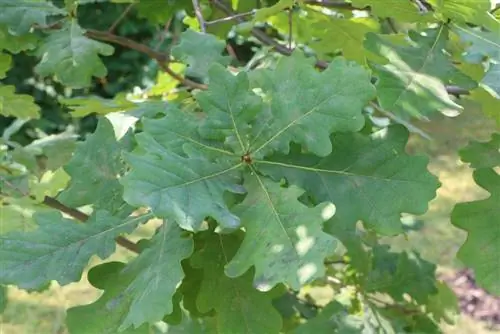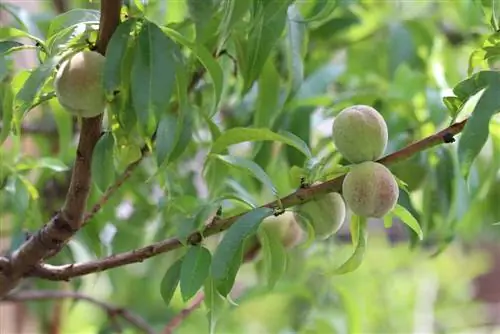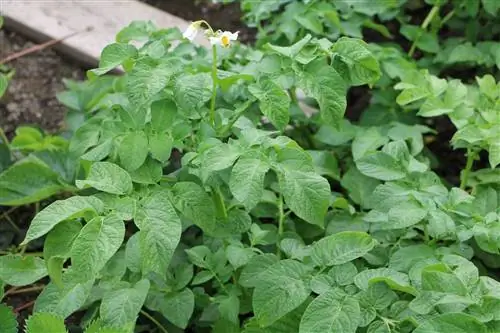- Author admin [email protected].
- Public 2023-12-17 03:39.
- Last modified 2025-06-01 06:48.
Oaks are among the most popular trees in our latitudes. They were once even considered sacred trees by many peoples. Although they do not produce fruit, they can live for several hundred years and have a mighty canopy that can become home to many small animals. It therefore stands for strength and longevity.
No wonder that many people want to plant at least one oak tree in their lives. This ritual is often used after the birth of a child. The child should emulate the oak and grow up big and strong and have a long life expectancy. However, in order for an oak tree to be planted, a little preparatory work is required. Especially if you don't want to buy a cultivated tree from a specialist store, but rather do everything yourself, from the acorn to the finished tree. This is required:
- a pre-germinated acorn
- Earth from the forest
- Plant bowl
- Pot
- Water
- patience
The Seed
The acorn seed comes from the fruit and can be used for cultivation without much effort. On wet autumn days you can often see how the acorns burst open and the seedling looks for a way to freedom. Training as a forester or even gardener is therefore not necessary if an oak tree is to be grown. All you need is a little patience, sun, water and good soil.
The seedling
In principle, it doesn't matter which acorn you use for rearing. The only important thing is that, if possible, no maggots have already chosen the acorn as their roost. To get the acorn, you should plan a walk to an oak tree in the spring after the snow has melted. As a rule, there are still enough acorns to be found under the trees even after winter. They have the advantage that they have usually already burst open and you can easily see whether the acorn is germinating or not. However, if acorns are collected in the fall, no one can say exactly whether a germ will form. Breeding would take more time and be significantly more risky.
The Earth
No earth, no tree. This simple rule should be well known. For an oak tree, the best case scenario is to take the soil that can be found in the vicinity of where the acorn was found. It is optimally tailored to the needs of the tree, even if it is currently only available as a seedling.
The Container
No pot is needed for the further development of the seedling. It is too deep and can make growing difficult at this stage. It is better if you use flat bowls. Laboratory dishes are particularly suitable. They have a relatively wide surface and are so flat that they are ideal for sprouting seedlings.
Tip:
Not everyone can call laboratory dishes their own. Therefore, coasters for flower pots with a large radius or coasters for flower boxes can also be used as an alternative.
After choosing the right container, it should be filled with the soil that was taken from near the oak tree. The acorn should be placed on the ground. There is no need to dig in. Once this has been done, all that remains is to ensure that the soil is always kept evenly moist. But not too moist, as waterlogging could cause the acorn to mold and the dream of having your own tree would then be dashed.
The first phase of growth

It takes around a week until the acorn cracks further and the first root can be seen. It grows horizontally from the glans and is about one centimeter long. As it continues to grow, this small root bends vertically downwards and grows into the earth. So you don't have to do anything yourself, you don't have to turn the acorn or cover the root with soil. Mother Nature does this all by herself.
The Pot
While the root finds its way into the earth, the first sprout and its tiny leaves also sprout. You should now wait a few days until the small plant gets a new container to grow. Since the oak is a taproot species, it is used to drilling its roots deep into the earth. This is only possible to a limited extent with the plant bowl. For this reason, you should switch to a pot in good time that offers more space for the roots.
The pot should be relatively high to provide enough space. Here too, soil from the forest can be used. For proper growth, attention must also be paid to sufficient moisture and sun. If the temperatures allow it and are above freezing, the pot can be placed outside.
Tip:
Such small, delicate plants, even if they later become a thick, gnarled oak tree, should not be exposed to frost. The small shoots can be destroyed by the frost and all previous effort would have been in vain. Only when the small tree has outgrown the pot should it be planted in an open area.
The Tree
An oak tree does not become a strong, shady tree overnight. “Good things take time” - this saying probably best fits the growth process. When the protected pot is separated into an open space. There are a few things that need to be taken into account. This means that an oak tree not only becomes very large, but also old. There must therefore be enough space for the tree, which should not simply be planted carelessly in the garden. It must also be borne in mind that the leaves of the oak tree rot only with difficulty. It is therefore not suitable for composting. Anyone who brings such a tree onto their own property must be aware that the tree loses many leaves in autumn and that these must be disposed of. Which, by the way, also applies to the acorns that the tree produces every year.
The small and newly exposed tree should also be protected from animals and careless approaches. In the first few years it is advisable to build a small fence around the tree and support the delicate trunk so that it does not collapse.
Tip:
Acorns are often accepted by animal parks and zoos to feed the animals. However, you should ask in advance how much you need and what quantities can be purchased.
What you should know about oak in brief
- The oak belongs to the so-called beech family and the group of deciduous trees.
- An oak tree can live up to 800 years and reach a height of around 40 meters.
- The seed from which an oak tree grows is called an acorn. It bears its first acorns after about 15 years.
- You can find them where the oak grows and drops its acorns, including in oak forests.
- After planting an acorn, it takes around fifty years until an oak tree grows from it.
- The oak has a special status, especially in the history of the Germanic peoples and Celts, as an offering to the gods and as a magic potion.
Plants
- First you need an acorn. These are found in oak forests on the forest floor. The glans should have cracked a little at one point.
- The right time to plant an acorn is after the snow has melted, which is early to mid-February.
- All you need is an acorn and a shallow vessel, such as a deep plate or a dessert bowl.
- The acorn seedling thrives best in the soil next to an existing oak tree. But this is not a must.
- The acorn must be watered regularly, especially in dry summer months.
- In general, the soil in which the acorn seedling is placed should always be moist. The seedling also needs a lot of sunlight.
- When the seedling starts to grow, you can see the first results after just a week.
- A root about 1 cm long appears on its surface. This then grows back into the earth at a right angle.
- Then the first leaves grow on a sprout. The root and the seedling always have approximately the same growth length.
- Since the roots of the oak tree always grow vertically into the earth, the roots will soon continue to grow horizontally in the container.
- Finally, you can also transplant the oak into a larger container. Here again, the soil must be kept well moist.






